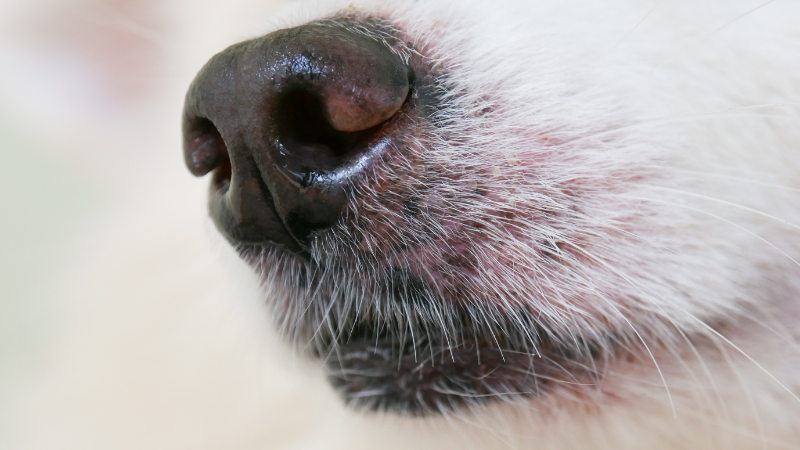Dogs have slits in their nose to help them detect scent particles in the air. The unique anatomy of dogs is fascinating, with one peculiar feature being the slits in their nose.
These slits serve a crucial purpose in their lives, allowing dogs to have an exceptional sense of smell. Dogs possess an incredible olfactory system that allows them to detect even the faintest scent particles in the air. These slits in their nose aid in this remarkable ability, acting as specialized receptors to capture and analyze scent molecules.
Understanding why dogs have slits in their nose sheds light on their incredible sense of smell, which has been honed over years of evolution. Through this article, we will delve deeper into the significance of these slits and explore how they contribute to the extraordinary olfactory capabilities of our canine companions.
Anatomy Of A Dog’s Nose
The nose is an incredible organ for dogs, serving a variety of purposes beyond just sniffing. It is not simply a feature that enhances their appearance, but a complex structure that plays a crucial role in their overall well-being and survival. Understanding the anatomy of a dog’s nose can help you appreciate its remarkable capabilities and shed light on fascinating aspects such as the presence of slits. In this section, we will delve into the external and internal structures of a dog’s nose to gain a deeper understanding of this extraordinary organ.

External Structure
The external structure of a dog’s nose is what we see on the surface. It consists of several components designed to facilitate their remarkable sense of smell:
- Nostrils: Dogs have a pair of nostrils, one on each side of their nose. These external openings allow the entry of scent molecules into the nasal cavity.
- Muzzle: The muzzle, also known as the snout, is the elongated part of a dog’s face that encompasses the nose. It varies in size and shape among different breeds, and interestingly, certain breeds have specialized muzzles that enhance specific olfactory abilities.
- Vibrissae: Vibrissae, more commonly known as whiskers, are another prominent feature of a dog’s nose. These specialized sensory hairs are capable of detecting subtle changes in the surrounding environment, aiding dogs in navigating and sensing objects in their vicinity.
Internal Structure
While the external structure of a dog’s nose is fascinating, it is the internal structure that truly sets it apart. Here’s a breakdown of the key components:
- Nasal Cavity: The nasal cavity is a hollow space located within the skull. Its walls are lined with a highly specialized tissue called olfactory epithelium, which contains millions of olfactory receptor cells responsible for detecting and processing scents.
- Turbinates: The nasal cavity of dogs contains thin, bony structures known as turbinates, which function to increase the surface area for odor detection. These intricate shelves also help warm and humidify the air as it enters the nose, enhancing the efficiency of scent detection.
- Jacobson’s Organ: Dogs possess an additional sensory structure called Jacobson’s organ, or the vomeronasal organ. Located on the roof of the mouth, this structure allows dogs to detect pheromones, which are chemicals produced by other animals. It plays a crucial role in communication and provides dogs with valuable information about potential mates, rivals, and other important signals in their environment.
- Slits in the Nose: Now, let’s address the intriguing presence of slits in a dog’s nose. These small vertical or horizontal slits, known as philtrum, can be observed on the midline of the external part of their nose. Although their exact purpose is still debated among scientists, one theory suggests that they help to moisten and lubricate the nose, aiding in scent detection by capturing moisture and enhancing the dog’s ability to pick up scents from the air.
Understanding the intricate anatomy of a dog’s nose helps us appreciate the remarkable capabilities of this organ. From their acute sense of smell to the presence of unique structures like Jacobson’s organ and slits in their nose, dogs possess an extraordinary olfactory system that surpasses our own. The next time you observe your furry friend sniffing the air or tracking scents with precision, you can marvel at the complexity hidden within their adorable nose.

Purpose Of Slits In A Dog’s Nose
Have you ever wondered why dogs have those unique slits in their noses? These slits serve multiple purposes that are essential for their survival and well-being. Understanding the purpose behind these nose slits can provide fascinating insights into a dog’s extraordinary sense of smell and their ability to navigate their environment with great precision.
Enhanced Olfactory Ability
The primary purpose of the slits in a dog’s nose is to enhance their olfactory ability, which is far more advanced compared to humans. Dogs possess a highly developed sense of smell, enabling them to detect scents that are undetectable to our human noses. The slits in their nose facilitate the separation of airflow, directing a portion of it towards the specialized smelling area of their nose called the vomeronasal organ or Jacobson’s organ.
Dogs rely heavily on their sense of smell for various reasons, including hunting, tracking, and identifying potential threats or dangers. These slits help dogs effectively analyze and interpret scents in their surroundings, allowing them to gather essential information about their environment, other animals, and even specific individuals.
Protection Against Dehydration
The slits in a dog’s nose also serve as a protective mechanism against dehydration. When dogs pant, they circulate air over the moist tissues on the inside of their nose, which helps to cool down their body temperature. The slits facilitate a steady flow of air, regulating the evaporation of moisture from their nasal tissues.
This unique adaptation is particularly crucial for dog breeds that are prone to overheating, such as those with short snouts. By allowing excessive heat to escape through their nasal slits, dogs can regulate their body temperature more effectively, reducing the risk of overheating and dehydration.
Regulation Of Airflow
In addition to enhancing their sense of smell and preventing dehydration, the slits in a dog’s nose also play a role in regulating airflow. These slits help control the direction and speed of the air entering the nasal passages, ensuring optimal delivery of scent molecules to the olfactory receptors. The slits work in conjunction with other nasal structures, such as turbinates, to filter and warm the incoming air, making it more efficient for the dog to process the scents.
This meticulous regulation of airflow not only aids in detecting scents but also helps dogs accurately track and locate the source of a particular odor. Whether it’s searching for hidden treats, detecting drugs or explosives, or locating missing individuals, a dog’s ability to track scents is greatly enhanced by their specialized nose structure.
In conclusion, the presence of slits in a dog’s nose serves multiple vital functions. They enhance a dog’s olfactory ability, protect against dehydration, and regulate airflow for improved scent detection and tracking capabilities. These adaptations highlight the extraordinary evolution of dogs and their remarkable ability to navigate the world through their highly advanced sense of smell.
Adaptation To Environment
Dogs are incredible creatures with a diverse range of physical features that allow them to thrive in various environments. One fascinating adaptation that can be observed in certain dog breeds is the presence of slits in their noses. These slits serve a purpose beyond just aesthetics, playing a crucial role in the dog’s ability to navigate and survive in its environment.
Dog Breeds With Slit Noses
Several dog breeds possess slits in their noses, distinguishing them from others. These breeds include:
- Basenji
- Borzoi
- Greyhound
- Saluki
- Whippet
Each of these breeds displays a unique set of characteristics, with slits in their noses being one of the most distinctive features. Let’s explore why these slits are beneficial for these particular breeds.
Evolutionary Advantage
The presence of slits in the noses of certain dog breeds can be traced back to their evolutionary past. These slits, technically known as nose fold slits or nose folds, are believed to have developed as an advantage for breeds that spend a significant amount of time running or hunting in environments with high speeds and strong airflow. The slits create a streamlined passage for air as it enters the dog’s nasal cavity, helping to reduce air resistance and improve breathing efficiency during intense physical activities.
By having slit noses, these breeds can achieve faster, more efficient oxygen intake, enabling them to maintain stamina and endurance over long distances or during high-speed pursuits. This unique adaptation is particularly advantageous for dogs participating in activities like coursing, hunting, and racing, where every bit of airflow optimization counts.
While slits in the nose contribute to improved breathing efficiency, they don’t compromise a dog’s sense of smell. Dogs have an exceptional olfactory system, with scent receptors far more powerful than our own. The slit doesn’t interfere with this vital sensory function, as there is no direct connection between the slits and the scent receptors located within the nasal cavity. Therefore, a dog with a slit nose can still effectively detect scents and navigate its environment based on smell.
In conclusion, the presence of slits in the noses of certain dog breeds demonstrates their incredible adaptation to specific environmental conditions. These slits provide an evolutionary advantage by reducing air resistance during high-speed activities, helping these breeds excel in running and hunting tasks. This adaptive feature showcases the remarkable diversity and ingenuity of the natural world, continually fascinating us with its intricacies.
Conclusion
To sum up, the presence of slits in dogs’ noses serves multiple essential functions. These furrow-like openings aid in their extraordinary sense of smell by capturing scent molecules more efficiently. Additionally, they help regulate the flow of air, preventing the nose from drying out.
Understanding the purpose of these slits allows us to appreciate the incredible adaptations that have shaped canines’ olfactory abilities. So next time you catch a glimpse of those nose slits, remember the remarkable capabilities they contribute to our beloved furry pals.








